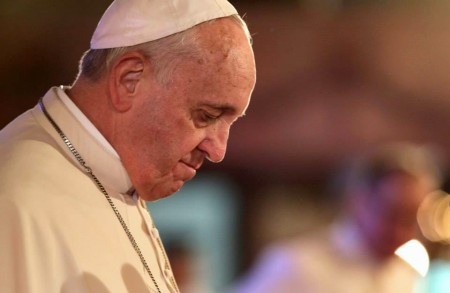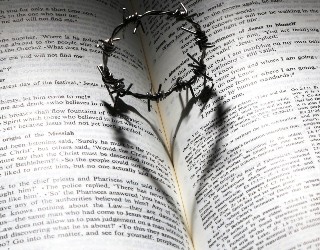 Hi readers, it seems you use Catholic Online a lot; that's great! It's a little awkward to ask, but we need your help. If you have already donated, we sincerely thank you. We're not salespeople, but we depend on donations averaging $14.76 and fewer than 1% of readers give. If you donate just $5.00, the price of your coffee, Catholic Online School could keep thriving. Thank you. Help Now >
Hi readers, it seems you use Catholic Online a lot; that's great! It's a little awkward to ask, but we need your help. If you have already donated, we sincerely thank you. We're not salespeople, but we depend on donations averaging $14.76 and fewer than 1% of readers give. If you donate just $5.00, the price of your coffee, Catholic Online School could keep thriving. Thank you. Help Now >
Liturgy: Covering of Crosses and Images in Lent
FREE Catholic Classes
And More on Mass Intentions
ROME, MARCH 9, 2005 (Zenit) - Answered by Father Edward McNamara, professor of liturgy at the Regina Apostolorum Pontifical University.
Q: Why are crosses and images covered during the last weeks of Lent? -- D.K., Oakland, California
A: First of all, I would first like to recommend Monsignor Peter Elliott's excellent guide "Celebrations of the Liturgical Year" published by Ignatius Press in 2002. It is a very useful resource for all those involved in the practical aspects of liturgical planning.
The duration of such veiling varies from place to place. The custom in many places is to veil from before first vespers or the vigil Mass of the Fifth Sunday of Lent while others limit this veiling from after the Mass of the Lord's Supper on Holy Thursday.
In some places images and statues are actually removed from the church and not simply veiled, especially after Holy Thursday.
Crosses are unveiled after the Good Friday ceremonies. All other images are unveiled shortly before the Mass of the Easter Vigil.
Neither the Stations of the Cross nor stained glass windows are ever veiled.
The bishops' conference may decide if the veiling during this period should be obligatory within its territory.
We ask you, humbly: don't scroll away.
Hi readers, it seems you use Catholic Online a lot; that's great! It's a little awkward to ask, but we need your help. If you have already donated, we sincerely thank you. We're not salespeople, but we depend on donations averaging $14.76 and fewer than 1% of readers give. If you donate just $5.00, the price of your coffee, Catholic Online School could keep thriving. Thank you.Help Now >
The veils are usually made of lightweight purple cloth without any decoration.
The custom of veiling the images during the last two weeks of Lent hails from the former liturgical calendar in which the Passion was read on the Fifth Sunday of Lent (hence called "Passion Sunday") as well as on Palm Sunday, Tuesday and Wednesday of Holy Week, and Good Friday.
For this reason the period following the Fifth Sunday of Lent was called Passiontide. A remnant of this custom is the obligatory use of the first Preface of the Lord's Passion during the Fifth Week of Lent.
As Monsignor Elliott remarks, "The custom of veiling crosses and images ... has much to commend it in terms of religious psychology, because it helps us to concentrate on the great essentials of Christ's work of Redemption."
Although this is true, the historical origin of this practice lies elsewhere. It probably derives from a custom, noted in Germany from the ninth century, of extending a large cloth before the altar from the beginning of Lent.
This cloth, called the "Hungertuch" (hunger cloth), hid the altar entirely from the faithful during Lent and was not removed until during the reading of the Passion on Holy Wednesday at the words "the veil of the temple was rent in two."
Some authors say there was a practical reason for this practice insofar as the often-illiterate faithful needed a way to know it was Lent.
Others, however, maintain that it was a remnant of the ancient practice of public penance in which the penitents were ritually expelled from the church at the beginning of Lent.
After the ritual of public penance fell into disuse -- but the entire congregation symbolically entered the order of penitents by receiving ashes on Ash Wednesday -- it was no longer possible to expel them from the church. Rather, the altar or "Holy of Holies" was shielded from view until they were reconciled to God at Easter.
For analogous motives, later on in the Middle Ages, the images of crosses and saints were also covered from the start of Lent.
The rule of limiting this veiling to Passiontide came later and does not appear until the publication of the Bishops' Ceremonial of the 17th century.
After the Second Vatican Council there were moves to abolish all veiling of images, but the practice survived, although in a mitigated form.
* * *
Follow-up: Mass Intentions
The feedback on the subject of Mass intentions and stipends (Feb. 22) has been most interesting and allows us to bring the question forward a little.
Before continuing, I must reiterate the essential point that the Mass has the same value as Christ's sacrifice on Calvary, hence infinite and so objectively speaking the number of intentions that may be offered is not limited.
The Church, however, normally allows only one intention with stipend united to each Mass.
In order to grasp the issues involved, it may help to realize what happens when a priest, or his representative, accepts a stipend to have a Mass said for a specific person or intention.
The person who has offered the stipend has not "bought a Mass," a thing which is patently impossible.
What has happened is that the priest has committed himself to celebrate a Mass according to the intentions of the person making the offering.
This intention is most often to recommend the soul of a deceased person but may also be for the personal intentions of the living.
In some cases the commitment is to ensure that the Mass is celebrated within a year, but frequently also involves other conditions such as a specific time or place for the Mass, especially to coincide with an anniversary of death or when the person requesting the Mass has great interest in personally participating in the celebration.
Once he has accepted the commitment the priest is bound in justice to fulfill it and may not normally accept or substitute other intentions for the same Mass.
The priest's intention is essentially a spiritual and internal act through which he commends the intention to God in a particular way even though he is free to offer up any number of other personal intentions.
He does not necessarily have to know the person for whom he is offering up the Mass. And in some cases -- for example, if unaware of the customs of the church where he is celebrating -- it is enough for him to know that an intention was requested and he celebrates the Mass according to the intention of the donor.
This aspect should throw light on the rather dicey subject of the public proclamation of the intentions.
Because the intention is essentially a spiritual act, its publication neither adds nor subtracts from its efficacy.
Indeed, publicly announcing the intention is done for the comfort of the living and not for the benefit of the dead.
Provided this is understood, there is usually no difficulty in making some form of announcement. But there are few official rules regarding this aspect.
We ask you, humbly: don't scroll away.
Hi readers, it seems you use Catholic Online a lot; that's great! It's a little awkward to ask, but we need your help. If you have already donated, we sincerely thank you. We're not salespeople, but we depend on donations averaging $14.76 and fewer than 1% of readers give. If you donate just $5.00, the price of your coffee, Catholic Online School could keep thriving. Thank you.Help Now >
Some parishes are content with posting a notice on a bulletin board or on its weekly broadsheet. Others prefer to announce the intention before Mass begins; others immediately after the greeting. Still others insert the name during the general intercessions.
Any one of these solutions is possible. It is not liturgically correct, however, to use the moment of silence after the "Let us pray" of the collect nor to habitually insert the name in the Eucharistic prayer, as this option is reserved to Masses for the dead such as funerals, first anniversaries, etc.
Sometimes, mishaps can occur, such as when a priest forgets to read out a name or cannot find it. In this case it is enough that he celebrated according to the intention of the donor.
If, on the other hand, he reads out the wrong name, and consequently celebrates the Mass for a different intention, then the parish should seek to remedy the situation by offering an alternative celebration at a suitable time.
A priest friend of mine was saved from this particular mistake by an attentive 10-year-old altar boy who nudged him while saying, "Father, you got the wrong dead guy."
Sometimes, more people request Mass intentions at which they desire to assist than is compatible with parish schedules, a situation ever more common due to the lack of priests.
To address this desire, the Holy See has authorized bishops to allow the celebration of Masses with several intentions. These "cumulative" Masses should not be daily practice. The Diocese of Rome allows parishes one such Mass a week and the faithful must be informed beforehand that there will be other intentions on that day.
The priest who celebrates such a Mass may retain only one stipend and must dedicate the others to the cause determined by the bishop.
The situation of these cumulative Masses is different from that prevalent in some poor countries in which many people ask the priest to remember them at Mass and often offer a tiny sum as a symbolic contribution. Such offerings are not considered stipends as the faithful are accustomed to Mass being offered for many intentions besides their own.
It is also different from enrollment in Mass associations of various types. In this case, a person who makes a donation to a monastery, sanctuary or religious community, either in their own name or to spiritually benefit another, is remembered in a general way at certain fixed Masses celebrated in the sanctuary or community.
When I was a seminarian, and then later a priest, several people sent me the spiritual gift of enrolling me in such associations -- and it is a source of comfort to know that one is being remembered at the altar.
It is a custom in my native Ireland, perhaps somewhat less so today, to send the family of a deceased friend or relative a condolence card announcing that Mass would be offered for the soul of the departed. In a world of faith, it certainly provides more comfort than flowers.
The usual amount for the stipend offering is determined by the bishops either nationally or locally. The faithful are free to offer more if they desire, and priests are encouraged to celebrate Mass for the intentions of their faithful even if they are too poor to offer a stipend.
Contact
Catholic Online
https://www.catholic.org
CA, US
Catholic Online - Publisher, 661 869-1000
info@yourcatholicvoice.org
Keywords
Liturgy, Lent, Mass, Cross, Images, Intentions
More Catholic PRWire
Showing 1 - 50 of 4,716
A Recession Antidote
Randy Hain
Monaco & The Vatican: Monaco's Grace Kelly Exhibit to Rome--A Review of Monegasque-Holy See Diplomatic History
Dna. Maria St. Catherine Sharpe, t.o.s.m., T.O.SS.T.
The Why of Jesus' Death: A Pauline Perspective
Jerom Paul
A Royal Betrayal: Catholic Monaco Liberalizes Abortion
Dna. Maria St.Catherine De Grace Sharpe, t.o.s.m., T.O.SS.T.
Embrace every moment as sacred time
Mary Regina Morrell
My Dad
JoMarie Grinkiewicz
Letting go is simple wisdom with divine potential
Mary Regina Morrell
Father Lombardi's Address on Catholic Media
Catholic Online
Pope's Words to Pontifical Latin American College
Catholic Online
Prelate: Genetics Needs a Conscience
Catholic Online
State Aid for Catholic Schools: Help or Hindrance?
Catholic Online
Scorsese Planning Movie on Japanese Martyrs
Catholic Online
2 Nuns Kidnapped in Kenya Set Free
Catholic Online
Holy See-Israel Negotiation Moves Forward
Catholic Online
Franchising to Evangelize
Catholic Online
Catholics Decry Anti-Christianity in Israel
Catholic Online
Pope and Gordon Brown Meet About Development Aid
Catholic Online
Pontiff Backs Latin America's Continental Mission
Catholic Online
Cardinal Warns Against Anti-Catholic Education
Catholic Online
Full Circle
Robert Gieb
Three words to a deeper faith
Paul Sposite
Relections for Lent 2009
chris anthony
Wisdom lies beyond the surface of life
Mary Regina Morrell
World Food Program Director on Lent
Catholic Online
Moral Clarity
DAN SHEA
Pope's Lenten Message for 2009
Catholic Online
A Prayer for Monaco: Remembering the Faith Legacy of Prince Rainier III & Princess Grace and Contemplating the Moral Challenges of Prince Albert II
Dna. Maria St. Catherine Sharpe
Keeping a Lid on Permissiveness
Sally Connolly
Glimpse of Me
Sarah Reinhard
The 3 stages of life
Michele Szekely
Sex and the Married Woman
Cheryl Dickow
A Catholic Woman Returns to the Church
Cheryl Dickow
Modernity & Morality
Dan Shea
Just a Minute
Sarah Reinhard
Catholic identity ... triumphant reemergence!
Hugh McNichol
Edging God Out
Paul Sposite
Burying a St. Joseph Statue
Cheryl Dickow
George Bush Speaks on Papal Visit
Catholic Online
Sometimes moving forward means moving the canoe
Mary Regina Morrell
Action Changes Things: Teaching our Kids about Community Service
Lisa Hendey
Easter... A Way of Life
Paul Spoisite
Papal initiative...peace and harmony!
Hugh McNichol
Proclaim the mysteries of the Resurrection!
Hugh McNichol
Jerusalem Patriarch's Easter Message
Catholic Online
Good Friday Sermon of Father Cantalamessa
Catholic Online
Papal Address at the End of the Way of the Cross
Catholic Online
Cardinal Zen's Meditations for Via Crucis
Catholic Online
Interview With Vatican Aide on Jewish-Catholic Relations
Catholic Online
Pope Benedict XVI On the Easter Triduum
Catholic Online
Holy Saturday...anticipation!
Hugh McNichol












 Daily Readings for Friday, April 19, 2024
Daily Readings for Friday, April 19, 2024 St. Alphege: Saint of the Day for Friday, April 19, 2024
St. Alphege: Saint of the Day for Friday, April 19, 2024 Stewardship Prayer: Prayer of the Day for Friday, April 19, 2024
Stewardship Prayer: Prayer of the Day for Friday, April 19, 2024

